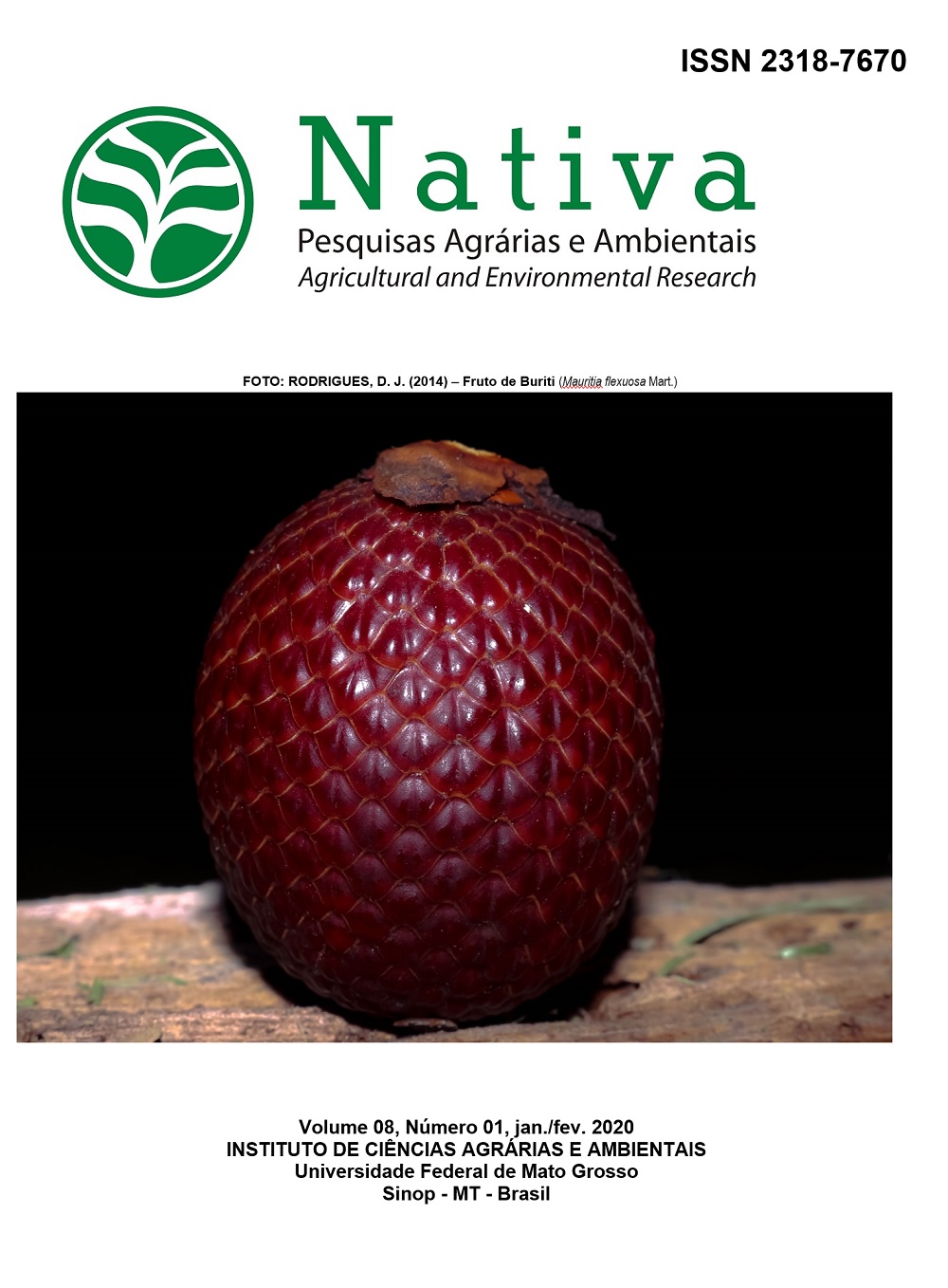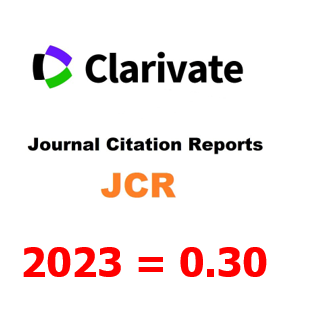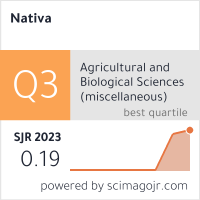ESTUDO DA CAPACIDADE DE REGULARIZAÇÃO DE VAZÃO NA BACIA DO RIBEIRÃO SÃO BARTOLOMEU VISANDO ABASTECIMENTO PÚBLICO
DOI:
https://doi.org/10.31413/nativa.v8i1.8251Resumo
O objetivo do presente trabalho foi avaliar a viabilidade de implantação de novos reservatórios de regularização de vazões na bacia do ribeirão São Bartolomeu, Minas Gerais, Brasil. Foram estudadas duas regiões para implementação de novos reservatórios. O cálculo da capacidade máxima de regularização foi realizado com base na metodologia conhecida como diagrama de massas. Para o dimensionamento da estrutura de emergência, foi realizado o cálculo da vazão máxima de projeto a partir do método racional modificado. A vazão média evaporada do período de estudo resultou em 4,5 L s-1 e 1,0 L s-1 para os reservatórios. Foram obtidos volumes úteis de 375.216 m³ e 66.596 m³ e profundidades máximas de 16,2 m e 17,7 m. As áreas dos espelhos de água equivaleram a 93.348 m² e 18.041 m². Tendo em vista o quadro de escassez hídrica no município de Viçosa, recomenda-se a implantação de um dos reservatórios, com aumento da disponibilidade hídrica para fins de abastecimento público. Entretanto, são necessários maiores estudos em relação à potencialidade de aumento dos conflitos por recursos hídricos na bacia. Adicionalmente, ressalta-se a necessidade da avaliação de potenciais alterações na qualidade da água do rio a jusante dos reservatórios propostos.
Palavras-chave: disponibilidade hídrica; ponto de captação; reservatórios.
STUDY OF FLOW REGULATION CAPACITY IN THE SÃO BARTOLOMEU RIVER BASIN FOR WATER SUPPLY
ABSTRACT:
This paper aimed to evaluate the viability of the implementation of new reservoirs to regulate flow in the São Bartolomeu river basin, Minas Gerais, Brazil. Two regions were studied. The maximum regularization capacity was calculated based on the methodology known as mass diagram. For the dimensioning of the emergency structure, the maximum design flow was calculated from the modified rational method. The mean evaporated flow of the study period resulted in 4.5 L s-1 and 1.0 L s-1. Useful volumes of 375,216 m³ and 66,596 m³ and maximum depths of 16.2 m and 17.7 m were obtained. The water mirrors areas obtained for the new dams amounted to 93,348 m² and 18,041 m². Considering the situation of water scarcity in the municipality of Viçosa, it is recommended to install one of the proposed reservoirs, with increased availability of water for public supply. However, further studies are needed regarding the potential for increasing conflicts over water resources in the basin. In addition, the need to evaluate changes in river water quality downstream the proposed reservoirs is emphasized.
Keywords: water availability; catchment point; reservoirs.
Referências
ALTHOFF, D.; RODRIGUES, L. N.; SILVA, D. D. da; BAZAME, H. C. Improving methods for estimating small reservoir evaporation in the Brazilian Savanna. Agricultural Water Management, Amsterdam, v. 216, p. 105-112, 2019. DOI: https://dx.doi.org/10.1016/j.agwat.2019.01.028
CARMO, E. J.; FERREIRA, I. O. Mapeamento dos relevos submersos das lagoas da UFV. Viçosa, MG: UFV, 2012. Relatório.
CHOW, V.T.; MAIDMENT, D.R.; MAYS, L.W. Applied hydrology. 1. ed. New York: McGraw-Hill, 1988. 572 p.
EUCLYDES, H.P. Saneamento agrícola: Atenuação das cheias; metodologia e projeto. 2. ed. Belo Horizonte: RURALMINAS, 1988. 320 p.
GARCIA-CUERVA, L.; BERGLUND, E. Z.; BINDER, A. R. Public perceptions of water shortages, conservation behaviors, and support for water reuse in the U.S. Resources, Conservation and Recycling, v. 113, p. 106-115, out. 2016. DOI: https://dx.doi.org/10.1016/j.resconrec.2016.06.006
GIONGO, P. R.; VETTORAZZI, C. A. Albedo da superfície por meio de imagens TM-Landsat 5 e modelo numérico do terreno. Revista Brasileira de Engenharia Agrícola e Ambiental, Campina Grande, v. 18, n. 8, p. 833-838., 2014. DOI: http://dx.doi.org/10.1590/1807-1929/agriambi.v18n08p833-838
HOGEBOOM, R. J.; KNOOK L.; HOEKSTRA, A.Y. The blue water footprint of the world's artificial reservoirs for hydroelectricity, irrigation, residential and industrial water supply, flood protection, fishing and recreation. Advances in Water Resources, Amsterdam, v. 113, p. 285-294, mar. 2018. DOI: https://dx.doi.org/10.1016/j.advwatres.2018.01.028
HOLANDA, F. S. R.; ISMERIM, S. S.; ROCHA, I. P. DA; JESUS, A. S. DE; ARAÚJO FILHO, R. N. DE; MÉLLO JÚNIOR, A. V. DE. Environmental Perception of the São Francisco Riverine Population in Regards to Flood Impact. Journal of Human Ecology, New Delhi, v. 28, n. 1, p.37-46, 2009.
IBGE. IBGE cidades. Disponível em: <https://cidades.ibge.gov.br/brasil/mg/vicosa/panorama>. Acesso em: 30 set. 2019.
KOLADA, A. 2014. The effect of lake morphology on aquatic vegetation development and changes under the influence of eutrophication. Ecological Indicators, v. 38, p. 282-293. DOI: https://doi.org/10.1016/j.ecolind.2013.11.015
LEROUX, A. D.; MARTIN, V. L; ZHENG, H. Addressing water shortages by force of habit. Resource and Energy Economics, v.53, p.42-61, 2018. DOI: https://dx.doi.org/doi:10.1016/j.reseneeco.2018.02.004
LI, S.; ZHANG, Q. Carbon emission from global hydroelectric reservoirs revisited. Environmental Science and Pollution Research, v. 21, n. 23, p. 13636–13641, 2014. DOI: https://dx.doi.org/10.1007/s11356-014-3165-4
LOON, A. F. VAN; LANEN, H. A. J. VAN. Public perceptions of water shortages, conservation behaviors, and support for water reuse in the U.S. Resources, Conservation and Recycling, v. 113, p. 106-115, 2016. DOI: https://dx.doi.org/10.1016/j.resconrec.2016.06.006
MARTINS, D. DE M. F.; CHAGAS, R. M.; MELO NETO, J. DE O. MÉLLO JÚNIOR, A. V. Impactos da construção da usina hidrelétrica de Sobradinho no regime de vazões no Baixo São Francisco. Revista Brasileira de Engenharia Agricola e Ambiental, Campina Grande, v. 15, n. 9, p. 1054–1061, 2011. DOI: http://dx.doi.org/10.1590/S1415-43662011001000010
MATOS, A. T., SILVA, D. D., PRUSKI, F. F. Barragens de terra de pequeno porte. Viçosa: Editora UFV, 2012. 136 p.
MEKONNEN, M. M.; HOEKSTRA, A. Y. The blue water footprint of electricity from hydropower. Hydrol. Earth Syst. Sci., v. 16, n. 1, p. 179-187, 2012. DOI: https://dx.doi.org/10.5194/hess-16-179-2012
MORENO, Y. M.; VÉLEZ, F.; RAMÍREZ, N. A. Características morfométricas de un lago de plano inundable tropical (ciénaga Hoyo Los Bagres, Colombia). Revista Facultad de Ingeniería Universidad de Antioquia, n. 59, p. 203-214, jun. 2011.
NETO, J. F. B.; COELHO, R. M. P. A morfometria e o estado trófico de um reservatório urbano: Lagoa do Nado, Belo Horizonte, Estado de Minas Gerais. Acta Scientiarum - Biological and Health Sciences, Maringá, v. 24, n. 2, p. 285–290, 2002.
PAUL, N.; ELANGO, L. Predicting future water supply-demand gap with a new reservoir, desalination plant and waste water reuse by water evaluation and planning model for Chennai megacity, India. Groundwater for Sustainable Development, v. 7, p. 8-19, set. 2018. DOI: https://dx.doi.org/10.1016/j.gsd.2018.02.005
PEARCE, F. Dams make water shortages even worse. New Scientist, v. 234, n. 3131, p. 16, 2017. DOI: https://dx.doi.org/10.1016/S0262-4079(17)31201-0
PENMAN, H. L. Evaporation: an introductory survey. Netherlands Journal of Agricultural Science, Cambridge, v. 4, n. 1, p. 9-29, 1956.
PENMAN, H. L. Natural evaporation from open water, bare soil and grass. Proceedings of the Royal Society, London, v. 193, n 1032, p. 120-145, 1948. DOI: https://dx.doi.org/10.1098/rspa.1948.0037
PEREIRA, D. DOS R.; MARTINEZ, M. A.; PRUSKI, F. F.; SILVA, D. D. da. Hydrological simulation in a basin of typical tropical climate and soil using the SWAT model part I: Calibration and validation tests. Journal of Hydrology: Regional Studies, v. 7, p. 14-37, 2016. DOI: https://dx.doi.org/10.1016/j.ejrh.2016.05.002
PEREIRA, L. F.; CALEGARIO, A. T.; PEREIRA, S. B.; ARAÚJO, U. L.; SILVA, L N. O.; FERNANDES FILHO, E, I, Caracterização e mapeamento da degradação e intensidade de uso da terra exercida por pastagens. In: Simpósio Mineiro de Ciência do Solo, 4., Anais... Viçosa: [s.i.], p. 1-3, 2017.
PEREIRA, M. F. V. Contradições de uma “cidade científica”: processo de urbanização e especialização territorial em Viçosa (MG). Caminhos de Geografia - revista on line, Uberlândia, v. 18, n. 16, p. 197–206, 2005.
RIPPL, W. Capacity of Storage Reservoirs for Water Supply. Minutes of Proceedings of the Institution of Civil Engineers, London, v. 71, p. 270-278,1883.
RODRIGUES, J. M.; AMORIM, M. C. DE; SEDIYAMA, G. C.; COSTA, L. C.; RODRIGUES, R. DE Á. DIAS, A. DA S. CONSUMO DE ÁGUA COMO ELEMENTO ESTIMADOR DE POPULAÇÃO URBANA. In: encontro de geógrafos de América Latina, 12., Anais... Montevideo: Observatorio Geográfico de América Latina, 14 p., 2009.
SCHÄFER, A. E.; MARCHETT, C. A.; SCHUH, S. M.; AHLERT, S.; LANZER, R. M. Morphological characterization of eighteen lakes of the north and middle coast of Rio Grande do Sul, Brazil. Acta Limnologica Brasiliensia, Rio Claro, v. 26, n. 2, p. 199-214, 2014. DOI: http://dx.doi.org/10.1590/S2179-975X2014000200010
SHAMSUZZOHAA, M; RASHEDUZZAMANA, M; GHOSH, R. C. Building Resilience for Drinking Water Shortages through Reverse Osmosis Technology in Coastal Areas of Bangladesh. Procedia Engineering, v. 212, p.559-566, 2018. DOI: https://dx.doi.org/10.1016/j.proeng.2018.01.072
TORRES, C. J. F.; BRAMBILLA, M.; FONTES, A. S.; MEDEIROS, Y. D. P. Conflitos pelo uso da água para a irrigação, geração de energia. Revista Gestão & Sustentabilidade Ambiental, Palhoça n. esp., p. 195–210, 2015. DOI: http://dx.doi.org/10.19177/rgsa.v4e02015195-210
ZHAO, D.; LIU, J. A new approach to assessing the water footprint of hydroelectric power based on allocation of water footprints among reservoir ecosystem services. Physics and Chemistry of the Earth, Oxford, v. 79–82, p. 40-46, 2015. DOI: https://dx.doi.org/10.1016/j.pce.2015.03.005
ZHUO, L.; HOEKSTRA, A. Y.; WU, P.; ZHAO, X. Monthly blue water footprint caps in a river basin to achieve sustainable water consumption: The role of reservoirs. Advances in Water Resources, Southampton, v. 113, p. 285-294, 2018. DOI: https://doi.org/10.1016/j.advwatres.2018.01.028
Downloads
Publicado
Edição
Seção
Como Citar
Licença
Direitos Autorais para artigos publicados nesta revista são do autor, com direitos de primeira publicação para a revista. Em virtude de a aparecerem nesta revista de acesso público, os artigos são de uso gratuito, com atribuições próprias, em aplicações educacionais e não-comerciais.
A artigos publicados nessa revista, podem ser reproduzidos parcialmente ou utilizados como referência por outros autores, desde que seja cita a fonte, ou seja, a Revista Nativa.
Copyright for articles published in this journal are the authors, with first publication rights granted to the journal. The journal shows open access, and articles are free to use, with proper attribution, in educational and non-commercial.
The articles published in this journal may be reproduced in part or used as a reference by other authors, provided that the source is quoted.






